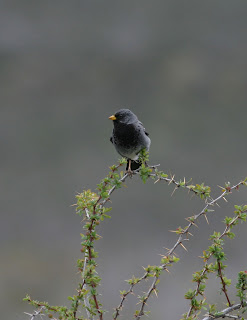Our second day in Torres we backtracked a bit right away in the morning to get a closer look at the Nineo bushes blooming. I remember this plant blooming from my first visit into the park but I hadn't been back at the right time of the year to see it again until now. They were just starting to bloom and the color of the blooms ranged from deep red to light orange. These plants (like most bushes in Patagonia) are dense and spiny, possibly a defense against Pleistocene herbivory. Today only the guanacos are left to graze on them. We did see a few guanacos too.

Neneo or Mata Guanaco (Anarthrophyllum desideratum)

Neneo with the Torres massif in the background.

Guanaco
One of the hard parts of leading people into the park who have never been there before is trying to convince them that they will see more guanacos closer to the road. The first views are generally outside the park and at a distance with the number of animals increasing closer to the park. I kept telling the people in the bus that we were not going to stop at each group of guanacos we came across and eventually we had good views of a number of herds of these interesting camelids. We were a bit early to see the new crop of young guanacos known as chulengas.

Guanaco
We stopped at the more popular waterfall, Salto Grande, where I now spend more time looking for flowers along the trail than looking at the waterfall. This trip I didn't even make it to the waterfall but I did find one orchid (below). This is the same area where we found a Magellanic Orchid (Chloraea magellanica) in January.

Zapatito de la Virgen (Calceolaria uniflora)
 Black-faced Ibis
Black-faced Ibis Long-tailed Meadowlark
Long-tailed Meadowlark Lesser Rhea
Lesser Rhea Firebush (Embothrium coccineum)
Firebush (Embothrium coccineum)The firebush was in full bloom too. On our way out of the park the hillsides were covered with this shrub in bloom and from a distance the hillsides looked rusty, like the leaves had turned.
We made our way to the Grey Glacier area and had lunch at the hotel there. After lunch we headed towards the beach at the end of the lake where small icebergs from the glacier often come to rest. The beginning part of the trail to the lake heads through some old Nothofagus (Southern Beech) trees with very evident sign of foraging Magellanic Woodpeckers, a species I have looked for without success since I began birding in Chile many years ago. A few years ago my guests even took a photo of a woodpecker to show me after we returned to the bus. He might have gotten away with it too but I recognized the photo from the bird book. Today was no different than any trip I have ever done to Glacier Grey. It rained and I didn't see a Magellanic Woodpecker. I did enjoy wonderful views of a Huemul however. The Huemul is the native deer to southern South America and is quite rare although I have been very lucky to observe them many times in Torres.
 Huemul (Hippocamelus bisulcus)
Huemul (Hippocamelus bisulcus)After we returned to the Hotel are Rio Serrano, Maritza, Sergio and I headed down the new road out of the park for a way just to see what the country was like. We found a small pond off the road with a pair of Spectacled Ducks and a couple of Ashy-headed Geese on it. I managed to get a couple of photos of the ducks and ran across a Chilean Flicker in the trees near the pond too.
 Chilean Flicker
Chilean Flicker
 Spectacled Duck
Spectacled Duck
 Chilean Flicker
Chilean Flicker Spectacled Duck
Spectacled DuckThe next morning we headed back to Punta Arenas via the new road. We stopped at the Milodon Cave on our way out. This is a spot the has more literary interest than real natural history interest as it is the supposed home of a piece of Milodon hide that has ties with Charles Darwin and Bruce Chatwin.
The next morning we joined the charter flight in Punta Arenas and flew to Ushuaia, Argentina and boarded the National Geographic Endeavour for the next phase of our journey - Antarctica











































